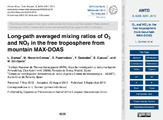Por favor, use este identificador para citar o enlazar este ítem:
http://hdl.handle.net/20.500.11765/6568
Long-path averaged mixing ratios of O3 and NO2 in the free troposphere from mountain MAX-DOAS [Discussion paper]
Registro completo de metadatos
| Campo DC | Valor | Lengua/Idioma |
|---|---|---|
| dc.contributor.author | Gómez Martín, Laura | es_ES |
| dc.contributor.author | Navarro Comas, Mónica | es_ES |
| dc.contributor.author | Puentedura, Olga | es_ES |
| dc.contributor.author | González Ramos, Yenny | es_ES |
| dc.contributor.author | Cuevas Agulló, Emilio | es_ES |
| dc.contributor.author | Gil-Ojeda, Manuel | es_ES |
| dc.date.accessioned | 2017-03-30T11:16:33Z | - |
| dc.date.available | 2017-03-30T11:16:33Z | - |
| dc.date.issued | 2013 | - |
| dc.identifier.citation | Atmospheric Measurement Techniques Discussions. 2013, 6, p. 8235–8267 | es_ES |
| dc.identifier.issn | 1867-8610 | - |
| dc.identifier.uri | http://hdl.handle.net/20.500.11765/6568 | - |
| dc.description.abstract | A new approximation is proposed to estimate O3 and NO2 mixing ratios in the northern subtropical free troposphere (FT). The proposed method uses O4 slant column densities (SCDs) at horizontal and near-zenith geometries to estimate a station-level differential path. The modified geometrical approach (MGA) is a simple method that takes advantage of a very long horizontal path to retrieve mixing ratios in the range of a few pptv. The methodology is presented, and the possible limitations are discussed. Multi-axis differential optical absorption spectroscopy (MAX-DOAS) high-mountain measurements recorded at the Izaña observatory (28° 18' N, 16° 29' W) are used in this study. The results show that under low aerosol loading, O3 and NO2 mixing ratios can be retrieved even at very low concentrations. The obtained mixing ratios are compared with those provided by in situ instrumentation at the observatory. The MGA reproduces the O3 mixing ratio measured by the in situ instrumentation with a difference of 28%. The different air masses scanned by each instrument are identified as a cause of the discrepancy between the O3 observed by MAX-DOAS and the in situ measurements. The NO2 is in the range of 20–40 ppt, which is below the detection limit of the in situ instrumentation, but it is in agreement with measurements from previous studies for similar conditions. | es_ES |
| dc.description.sponsorship | We acknowledge the support of AMISOC (Atmospheric Minor Species relevant to the Ozone Chemistry at both sides of the Subtropical jet, contract number CGL2011-24891), and NORS (Demonstration Network Of ground-based Remote Sensing Observations in support of the GMES Atmospheric Service) Integrated Project under the 7th Framework Program (contract number FP7-SPACE-2011-284421) | es_ES |
| dc.language.iso | eng | es_ES |
| dc.publisher | European Geosciences Union | es_ES |
| dc.rights | Licencia CC: Reconocimiento CC BY | es_ES |
| dc.subject | Ozone | es_ES |
| dc.subject | Gases traza | es_ES |
| dc.subject | Alta troposfera | es_ES |
| dc.subject | Free troposphere | es_ES |
| dc.subject | Ozono | es_ES |
| dc.title | Long-path averaged mixing ratios of O3 and NO2 in the free troposphere from mountain MAX-DOAS [Discussion paper] | es_ES |
| dc.type | info:eu-repo/semantics/article | es_ES |
| dc.relation.publisherversion | http://dx.doi.org/10.5194/amtd-6-8235-2013 | es_ES |
| dc.rights.accessRights | info:eu-repo/semantics/openAccess | es_ES |
| dc.relation.projectID | info:eu-repo/grantAgreement/EC/FP7/284421 | es_ES |
| Colecciones: | Artículos científicos 2010-2014 | |
Ficheros en este ítem:
| Fichero | Descripción | Tamaño | Formato | ||
|---|---|---|---|---|---|
| amtd-6-8235-2013.pdf | 1,69 MB | Adobe PDF |  Visualizar/Abrir |
Los ítems de Arcimis están protegidos por una Licencia Creative Commons, salvo que se indique lo contrario.





